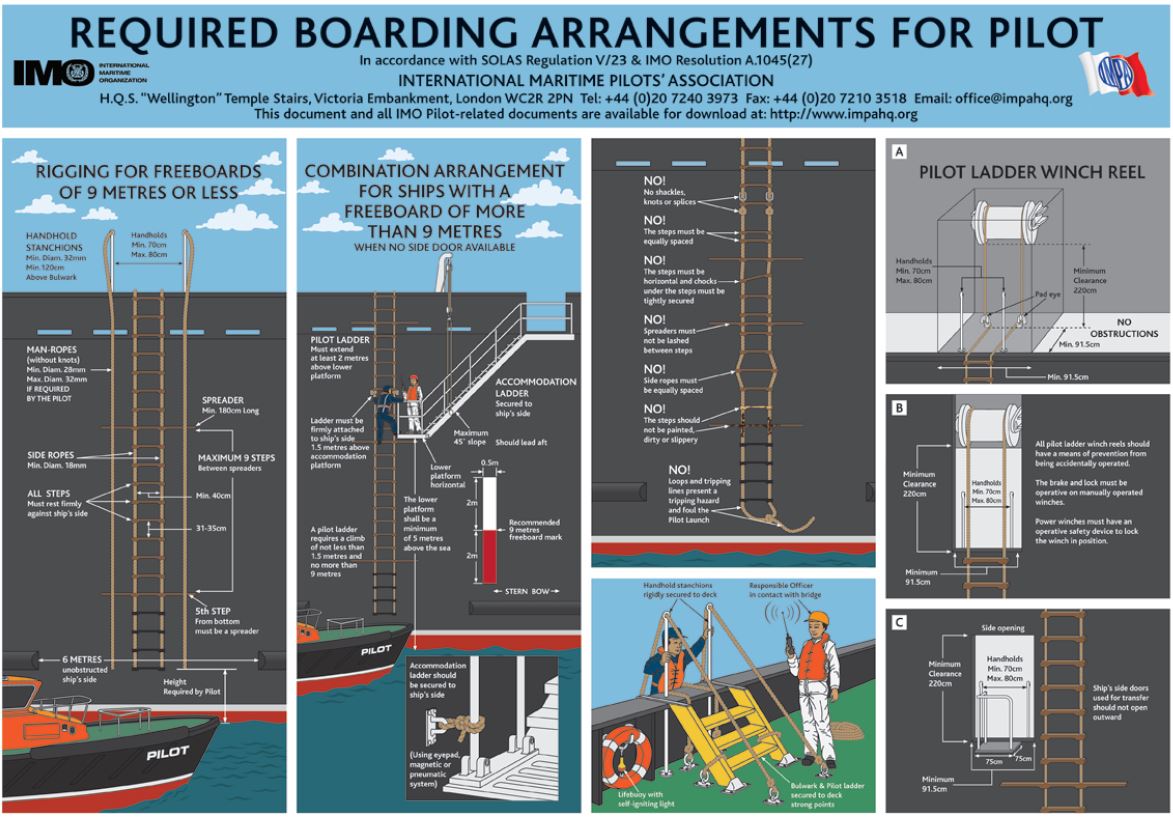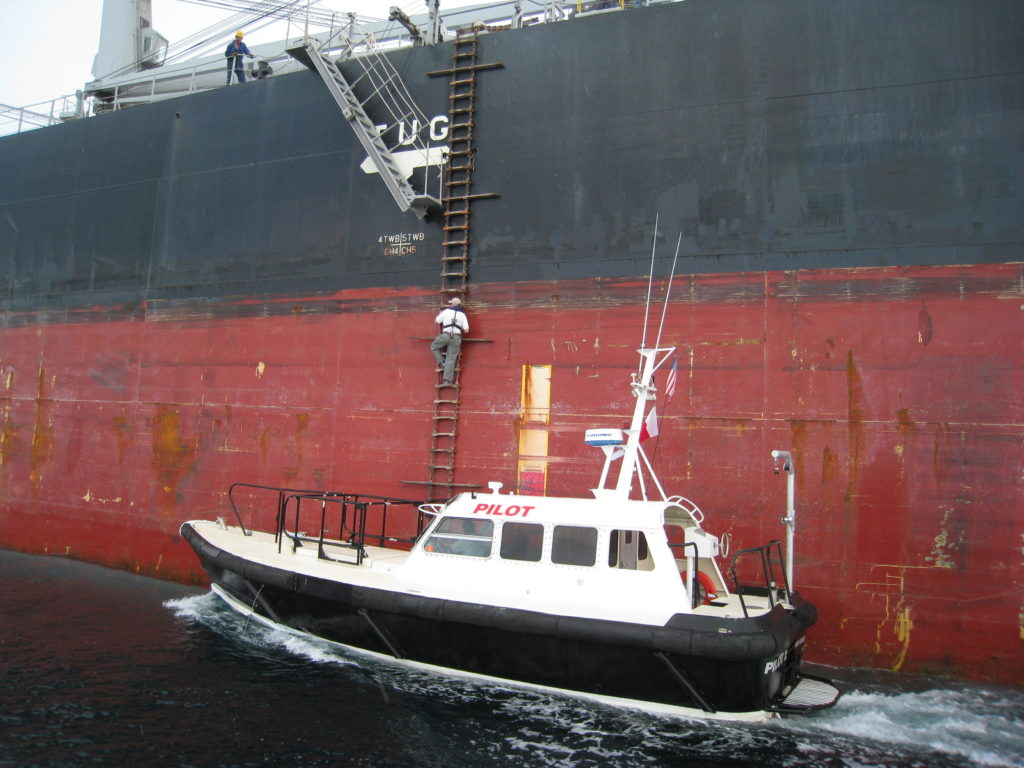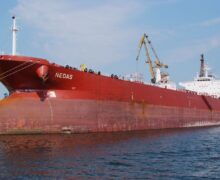
Vessel Pilotage Operations-Safe Pilot Transfers: Capt. Manjur Khan (19N)
Introduction
Vessel pilotage is a century old profession. Marine pilots come aboard ships to assist the master and crew to safely navigate through the most treacherous parts of the voyage, arriving and departing a port / harbour and estuary. These highly qualified mariners possess intimate local knowledge of the pilotage districts, and very highly developed ship handling skills to ensure safe arrival and departure of vessels. Traditionally, pilots embark and disembark ships using the rope constructed pilot ladder from and to a pilot vessel. This can prove to be a very hazardous procedure if those involved do not comply with the industry standards or fail to display good seamanship practices.
Seafarers are familiar with international requirements, industry standards & practices, and routinely conducting pilot transfers at sea. However, pilots still sustain serious injuries and fatalities across the world during transfers. This article is not intended to re-visit the knowledge mariners already have on providing safe transfer arrangements, rather aims to promote safety awareness, and the needs to prevent injuries and fatalities.
International Standards & Requirements
Safe pilot transfer is a partnership between pilots and the vessels being served. Recognising the hazardous nature of pilot transfers, the International Maritime Organisation (IMO) introduced measures through The Safety of Life At Sea 1974 (SOLAS) Regulation V/23 in July 2012 to improve the safety of pilot transfer arrangements provided by vessels.
SOLAS Regulation V/23 sets out the principal requirements for the rigging of pilot ladders while further detailed technical specifications for pilot ladders are found in IMO Resolution A.1045(27). The Maritime industry participants are also advised to make reference to the “Shipping Industry Guidance on Pilot Transfer Arrangements” published by The International Maritime Pilots’ Association (IMPA) and the International Chamber of Shipping (ICS) in 2012 as well as to the IMPA poster “Required Boarding Arrangements for Pilot”.
Australian Maritime Safety Authority’s (AMSA) Marine Notice 19/2015 – Use of Pilot Ladders could be consulted for advice. UK MCA Marine Guidance Notice (MGN), MGN-432 could also be consulted for further guidance on safety during transfers of persons to and from ships.
IMPA Safety Campaign
Years after the regulatory changes entered into force, results from a safety campaign carried out by the International Maritime Pilots’ Association (IMPA) show little sign of improvement. Defective boarding arrangements and unsafe rigging of pilot ladders remain a concern to pilots worldwide. IMPA’s safety campaign was carried out in October 2016. Its purpose was to investigate the standard of pilot ladders and associated equipment and monitor compliance with SOLAS.
In its campaign summary report, which was submitted to the IMO in November 2016, the IMPA states that:
• the overall non-compliance level of inspected pilot transfer arrangements was 17.8 per cent (up from 13.5 per cent in 2010 and 16.5 per cent in 2007);
• bulk carriers, fishing vessels and general cargo vessels are among the vessel types contributing the most to the non-compliances;
• the main defect types resulting in non-compliances are “defective pilot ladders”, e.g. ladders not resting against ship’s hull and “safety equipment defects”, e.g. missing lifebuoys with self-igniting light; and
• the deteriorating standard of seamanship is of concern, resulting in ladders being improperly rigged /secured.
The safety campaign results appear to be confirmed by data published by Port State Control (PSC) authorities. In 2015 the Australian Maritime Safety Authority (AMSA) in its Marine Notice 2015/19 reported a growing concern over the use of non-compliant or poorly configured pilot ladders by vessels calling at Australian ports. A review of Paris MOU Inspection Results for 2014 to 2017 provides no evidence that the number of deficiencies related to “Pilot ladders and hoist / pilot transfer arrangements” is declining.
Shipowners’ and Masters’ Responsibilities
The shipowners, operators, masters and crew have the legal responsibility to supply conforming pilot ladders and ship-borne fittings to all their vessels, and to ensure that vessels’ crew members involved in the transfer operations receive the necessary training. A full understanding of the risks involved and the requirements in force is essential in order to prevent accidents during pilot transfers.
However, compliance with the referenced standards does not in itself assure safety. The Master or responsible Deck Officer of the vessel providing the pilot ladder should therefore assess whether supplementary measures, such as the provision of lifejackets, harnesses, lifelines and lifebuoys should be put in place to assure the safety of personnel. As delays may result from the need to change an improperly rigged, inadequately maintained or poorly positioned pilot ladder, it is important that Masters and deck officers confirm with the pilotage provider the exact requirements for rigging the ladder before the vessel arrives at the agreed pilot boarding ground.
Incidents & Investigations
A high proportion of accidents to pilots occur at the top of the pilot ladder due to poorly designed access arrangements or inadequately rigged equipment. Further causes of accidents involving pilot ladders include defects in the ladder treads and /or side ropes and lack of proper attachment of the ladder to the vessel. Some pilot ladder related incidents & investigations are highlighted below for increased awareness:
Fall from the pilot ladder on board the MSC Ela, Liverpool, UK, on 4 August 2018:
UK Pilot Association reported – on 4th August 2018 a Port of Liverpool pilot was embarking the 294m LOA vessel MSC Ela. The pilot ladder parted at the deck level resulting in the pilot falling several metres on the deck of the pilot vessel sustaining injuries requiring hospitalisation. The broken ladder dropped on to the pilot boat narrowly missing the pilot and deck hand (UK MCA investigating).
Gangway failure leads to Marine Pilot’s death, La Quinta Channel, 16 June 2018:
MarEx 2018-06-20: The Aransas-Corpus Christi Pilot Association reported on Saturday 16 June 2018 a ship’s gangway collapsed as a senior pilot and another individual were boarding a docked vessel in La Quinta Channel causing both men to fall 20 feet into the water. It took 45 mins to recover the men and later the 65 year old senior pilot was pronounced deceased (USCG Safety Alert 14-18).
July 2018: Pilot ladder side rope failed during pilot disembarkation, Port of Dampier, Australia;
June 2017: Pilot ladder bottom step failed on one end as the weight was applied, Dampier, Australia;
Fall from the pilot ladder on board the chemical tanker Golden Concord, Goods Island, Torres Strait, Queensland, Australia on 4 July 2013:
On 4 July 2013, a coastal pilot was disembarking from the chemical tanker Golden Concord in the Torres Strait when the pilot ladder manrope he was holding appeared to give way. He was unable to establish a firm grip on the rope, lost his balance and fell to the deck of the pilot launch below. The pilot did not sustain any serious injuries, as his fall was arrested by the deckhand on board the launch (Full Report).
Person overboard from bulk carrier Jolbos with loss of one life, Newport, UK, 08 January 2006:
As the Cypriot registered bulk carrier Jolbos was leaving Newport, on 8 January 2006, two seamen were rigging a pilot ladder of the combination type. The ladder’s suspension wire failed, allowing the ladder to swing down and throw one of the seamen into the water. He was recovered by a nearby tug but, in spite of efforts to resuscitate him, was later declared dead in hospital (Full Report).
Fall from pilot ladder on board bulk carrier Atlantic Erie at Sydney, Nova Scotia, 03 November 1997:
While the pilot was disembarking off Sydney, during the hours of darkness and in inclement weather, a sudden movement of the pilot ladder caused the pilot to lose his grip on the ladder and fall onto the deck of the pilot boat, landing heavily and sustaining injuries (Full Report).
Conclusion
Whenever pilots embark or disembark from a ship by pilot ladder, they entrust their safety to the pilot transfer arrangements provided by the ship, its owner, operator, master and crew. The first impression is the best impression. A pilot faced with sub-standard boarding arrangements would naturally form a negative impression on the ship, its manning /on-board operations, and vice-versa. Pilots reserve the rights to refuse to board a vessel via unsafe means of access and report the same to relevant PSC authority potentially causing delays /detention of vessels, and subsequently causing demurrage.
In pilotage waters, primary objective of the master and crew should be getting the best services out of a pilot safely navigating the most hazardous part of the voyage. The Shipping Industry Guidance clearly states: “A pilot who has climbed a sound ladder, well rigged, and attended by an officer and a deck party will be in the right frame of mind to give his best attention to the safety of the vessel”.
Reference:
IMO: http://www.imo.org/en/KnowledgeCentre/IndexofIMOResolutions/Pages/Default.aspx
AMSA: https://www.amsa.gov.au/safety-navigation
ATSB: http://www.atsb.gov.au/publications/safety-investigation-reports/?mode=Marine
MAIB: https://www.gov.uk/government/publications/marine-accident-investigation-branch-current-investigations
NTSB: https://www.ntsb.gov/investigations/AccidentReports/Pages/marine.aspx
IMPA: http://www.impahq.org/downloads.php
IHMA: http://www.harbourmaster.org/
ICS: http://www.ics-shipping.org/
MarEx: https://maritime-executive.com/magazine
GARD-Norway: http://www.gard.no/web/topics/navigation
Transport Safety Canada: http://www.tsb.gc.ca/eng/rapports-reports/marine/index.asp
[Author – Capt. Manjur Khan (LinkedIn): master mariner (Aus), serving as Marine Pilot-Loading Master for LNG projects (Gorgon & Wheatstone). Previously served offshore support vessel operations management, Commonwealth of Australia (AMSA) & State (NSW) Maritime Regulatory Administrations; container liner shipping operations as Port Captain; and as seagoing officer / master on various ocean-going & offshore vessels.]











![[নোঙর 2016] আমার সেরা বিদেশ ভ্রমন : নাফিসা মাশহুরা ইরা](http://bdmariners.org/wp-content/uploads/2016/06/Dubai-city-tour-70x70.jpg)




Recent Comments